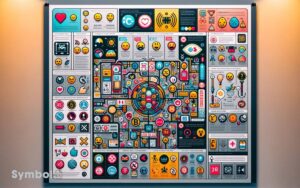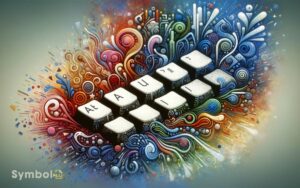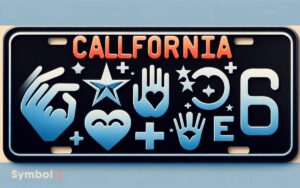Please Use the Word ‘Symbol’ in a Sentence
You've seen a red rose and instantly thought of love, right? That's because a rose is a symbol of love and beauty. From the stop sign at the corner to the emojis you send in a text, symbols are everywhere, carrying meanings deeper than their simple appearances.
Even punctuation marks, like a question mark or an exclamation point, serve as symbols in your writing, making your messages clearer and more impactful. And if you've ever worn a wedding band, you've carried a symbol of commitment and love on your own hand.
As you explore further, you'll unlock even more layers of understanding hidden in symbols around you.
Key Takeaways
- A rose is often used as a symbol of love and beauty in literature and art.
- The cross is a powerful symbol representing faith and hope across various cultures.
- Punctuation marks, like the exclamation point, serve as symbols to convey emotion and emphasis in writing.
- In mathematics, the equal sign (=) is a symbol that denotes equality between two expressions.
- The hourglass is a universal symbol of time passing and mortality.
Understanding Symbols
Throughout history, symbols have served as powerful tools for communication, allowing you to convey complex ideas with a simple image or sign. They're everywhere in your daily life, from the traffic lights guiding your commute to the logos representing your favorite brands.
You instinctively understand a red rose symbolizes love, just as a dove represents peace. These symbols transcend language barriers, offering a universal method of understanding. By recognizing and interpreting symbols, you're tapping into a deep well of human expression and connection.
It's not just about seeing an image; it's about grasping the beliefs, emotions, and concepts that lie beneath. Embracing this understanding enriches your interactions with the world, revealing layers of meaning in the everyday.
Symbols in Literature
How do symbols in literature enrich your reading experience by adding layers of meaning to the narrative?
When you dive into a book, symbols are the treasure beneath the surface. They're not just objects or characters; they're vessels carrying deeper significance.
A simple ring isn't just jewelry in a fantasy epic; it's power, corruption, or destiny. A storm brewing isn't just bad weather; it's turmoil, change, or conflict.
As you read, you're not just following a story. You're decoding a secret language, where every symbol opens a door to new interpretations and insights.
This doesn't just make your reading richer; it transforms it. You're not just a reader; you're a detective, piecing together clues that reveal the heart of the narrative.
Everyday Symbol Usage
Navigating your daily life, you're constantly interpreting symbols, from traffic lights signaling when it's safe to cross the street to emoticons conveying emotions in text messages. These symbols are shorthand for larger concepts, making communication faster and more efficient. Consider how frequently you encounter symbols without giving them a second thought.
| Symbol | Location | Meaning |
|---|---|---|
| �� | Texts | Happiness |
| ⛔ | Roads | No entry |
| ✔️ | Forms | Approved |
| �� | Ideas | New idea |
Symbols bridge language barriers, allowing for universal understanding. They're integral to making sense of the world around you. Whether it's a heart symbolizing love in a message or a red stop sign on the street, symbols shape your interaction with the environment, underscoring their everyday importance.
Symbolism in Art
In art, symbols serve as powerful tools, transforming simple visuals into complex narratives that speak directly to your emotions and intellect. Artists use symbols to convey messages that words alone can't express. For instance, a dove might symbolize peace, while a storm could represent turmoil or change.
You'll find that understanding the symbolism in a painting or sculpture adds layers of meaning to your experience of the artwork. It's like deciphering a secret language, where colors, shapes, and objects come together to tell a story or convey a message.
As you explore different pieces, you'll start to notice recurring symbols and begin to grasp the deeper themes artists are communicating. This process enriches your appreciation of art, making each encounter more personal and profound.
Crafting Sentences With Symbols
Now, let's tackle how you can craft sentences with symbols, starting with the basics of symbol usage.
You'll learn how to weave symbols creatively into your writing, enhancing both its depth and intrigue.
Symbol Usage Basics
You'll find that incorporating symbols into your sentences can add depth and clarity, enhancing the reader's understanding.
Symbols, in this context, aren't just graphical icons but also include punctuation marks, mathematical signs, and other characters that convey specific meanings or functions.
For instance, you might use an ampersand (&) to connect closely related ideas, saving space and maintaining flow. Similarly, employing an asterisk (*) can indicate a footnote or special note, directing the reader's attention to additional information without disrupting the main text.
It's crucial to remember that each symbol has its own set of rules for use. Misusing symbols can lead to confusion or misinterpretation. Therefore, it's important to familiarize yourself with these guidelines to ensure your writing remains clear and effective.
Creative Symbol Integration
Mastering the art of integrating symbols into your sentences can significantly elevate your writing's impact and efficiency. It's about choosing the right symbol to add depth or clarity without confusing your readers. You're essentially encoding more meaning into less space, making every word count.
Here's a table to get you started:
| Symbol | Common Use | Example Sentence |
|---|---|---|
| @ | At | Meet me @ the cafe. |
| # | Topic/Tag | I love #summer. |
| $ | Money | I owe you $5. |
| % | Percent | I'm 100% sure. |
| & | And | You & I will go. |
Symbols in Literature
In literature, symbols weave deeper meanings into narratives, allowing readers to uncover layers beyond the surface text. You're not just reading a story; you're embarking on a treasure hunt, where each symbol is a clue to understanding the deeper essence of the tale.
- *A white whale* becomes more than a marine creature; it symbolizes obsession and the destructive nature of pursuing an unattainable goal.
- *A green light* at the end of a dock isn't just a navigational aid; it represents the elusive dream and the distance between reality and aspiration.
- *A scarlet letter* transcends its initial shame to embody strength, resilience, and the complexity of human morality.
- *A raven* shifts from a mere bird to a portent of doom and a messenger of loss.
Every symbol is a thread, pulling you deeper into the fabric of the story.
Symbol Interpretation
To fully grasp a story's depth, it's crucial to unlock the meanings behind its symbols. When you're reading, pay attention to objects, characters, or events that seem to carry more weight than their surface value suggests. These are often symbols, acting as keys to deeper understanding.
Don't get frustrated if the meaning isn't immediately clear. Symbol interpretation involves looking at the context within the story and considering broader cultural or historical significances. Remember, symbols can have multiple interpretations, and there's often no single 'correct' answer. Your personal experiences and knowledge can greatly influence your interpretation, making your reading of the story unique.
Practice Exercises
Now that you're familiar with symbol interpretation, it's time to put your knowledge to the test with some practice exercises.
You'll explore the basics of symbol usage and the different types of symbols to see how they function in various sentences.
This hands-on approach will help you grasp the concepts more firmly and apply them with ease.
Symbol Usage Basics
Often, you'll find that mastering the use of the word 'symbol' can significantly enhance your writing skills. By incorporating symbols into your sentences, you're not just conveying information; you're inviting your readers to dive deeper into the underlying meanings of your words.
Here's how you can start:
- Think of symbols as shortcuts to convey complex ideas or emotions.
- Use them to add depth to your characters, settings, or themes.
- Remember, a symbol's power lies in its ability to evoke images or concepts without direct explanation.
- Practice by identifying objects or actions in your surroundings that could serve as symbols in your writing.
Types of Symbols
Before delving into specific examples, it's crucial you understand the variety of symbols that can enrich your narrative. Symbols aren't just objects; they're vehicles for conveying deeper meanings, emotions, and themes. Here's a quick guide to get you started:
| Type | Example | Meaning |
|---|---|---|
| Natural | Rose | Love, Beauty |
| Cultural | Cross | Faith, Hope |
| Conceptual | Chains | Oppression |
| Personal | Heirloom Ring | Family Legacy |
You'll find that using symbols effectively allows you to communicate complex ideas succinctly. Whether it's a natural symbol like a storm representing turmoil or a cultural symbol like a dove symbolizing peace, they add layers to your writing. Remember, the key is how these symbols resonate with your audience, making your narrative richer and more engaging.
Conclusion
You've been surrounded by symbols your whole life, yet you might still wonder how you'd use 'symbol' in a sentence. Isn't it ironic?
After diving into their meanings, exploring their appearances in literature, art, and everyday life, you're practically a symbol scholar now.
But when it comes down to it, perhaps the most symbolic thing of all is the challenge of encapsulating their essence into words.
So, as you step back into the world, remember, you're living in a masterpiece of symbols. Don't miss the irony in that.






